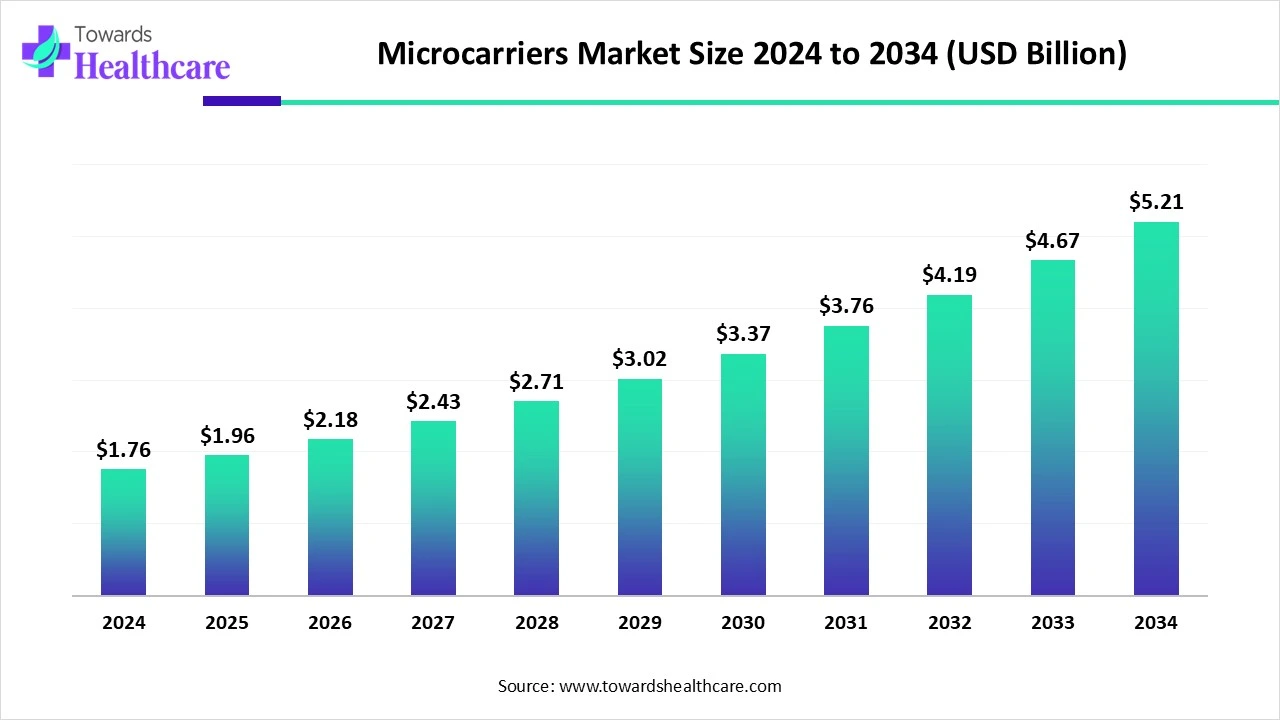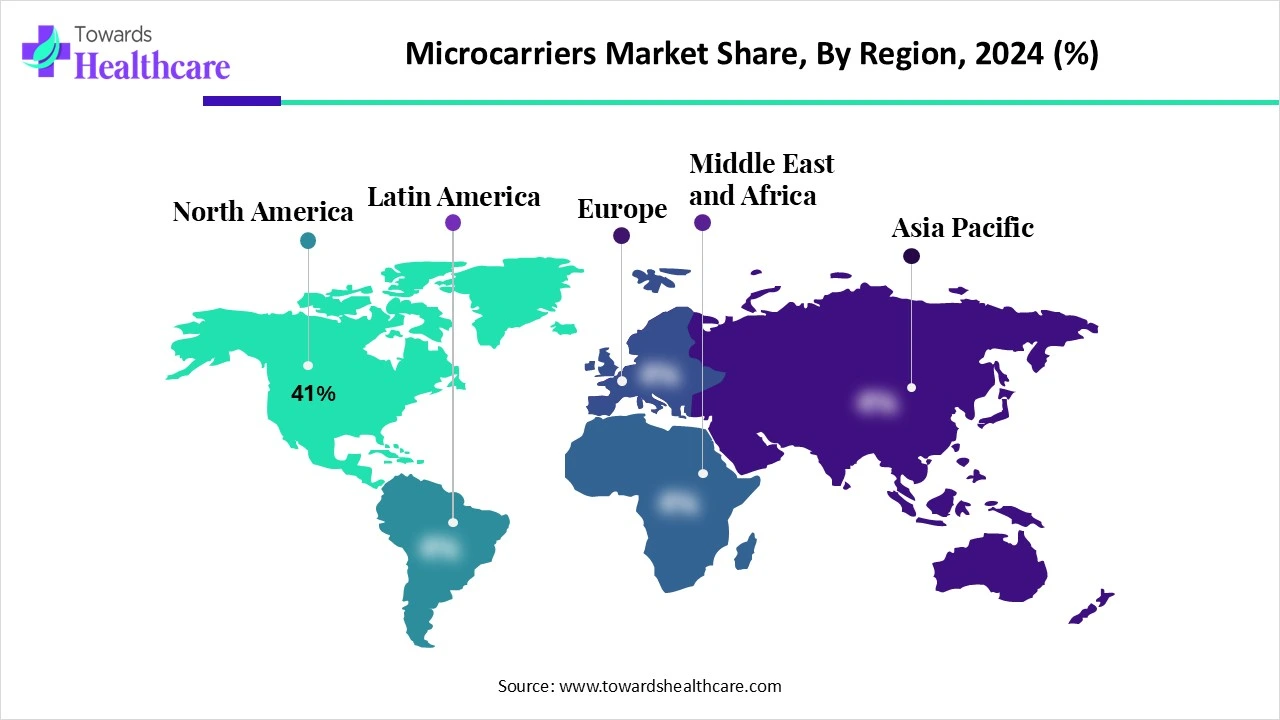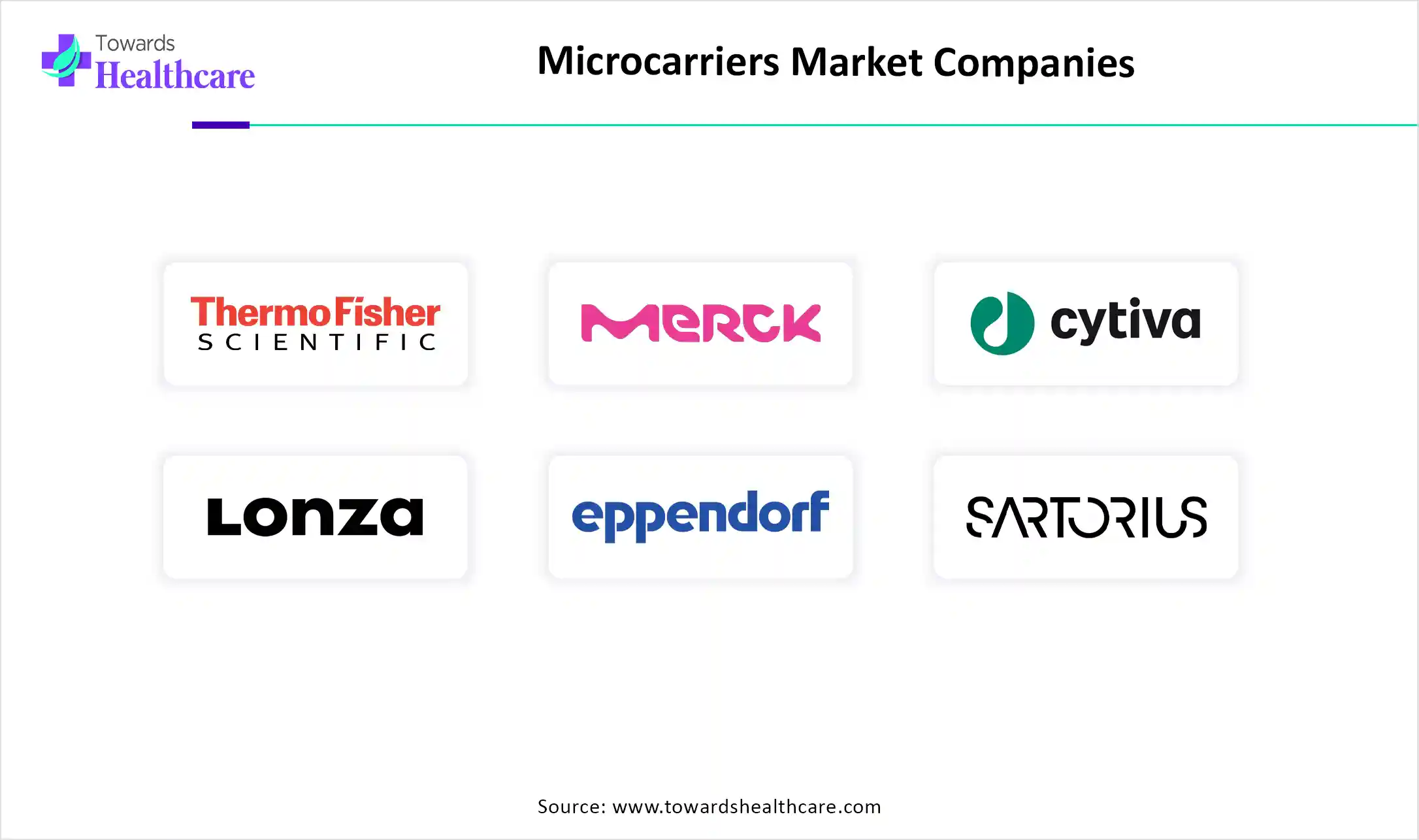December 2025

The global microcarriers market size is calculated at US$ 1.76 in 2024, grew to US$ 1.96 billion in 2025, and is projected to reach around US$ 5.21 billion by 2034. The market is projected to expand at a CAGR of 11.48% between 2025 and 2034.

The microcarriers market is expanding due to the increasing demand for cell-based vaccines, biopharmaceuticals, and regenerative medicine. North America is dominated in the market by technological advancements in cell culture and bioreactor processes, and increasing investment in R&D, while Asia Pacific is the fastest growing in the market due to the growing prevalence of chronic diseases and increasing demand for personalized medicine.
| Metric | Details |
| Market Size in 2025 | USD 1.96 Billion |
| Projected Market Size in 2034 | USD 5.21 Billion |
| CAGR (2025 - 2034) | 11.48% |
| Leading Region | North America share by 41% |
| Market Segmentation | By Product Type, By Material Type, By Type of Microcarrier, By Application, By End User, By Region |
| Top Key Players | Thermo Fisher Scientific Inc., Merck KGaA (MilliporeSigma), Cytiva (Danaher Corporation), Corning Incorporated, Lonza Group AG, Eppendorf SE, Sartorius AG, FUJIFILM Irvine Scientific, HIMEDIA Laboratories, Greiner Bio-One International GmbH, Solohill Engineering (now part of Pall Corporation), Danaher Corporation, Biotechne (R&D Systems), Beckman Coulter Life Sciences, Repligen Corporation, PBS Biotech, Inc., Nunc (Thermo Fisher brand), Scinor Biosystems, Advanced BioMatrix, CellGenix GmbH |
The microcarriers market encompasses microbead-based substrates that provide a surface for the attachment and growth of anchorage-dependent cells in bioreactors. They are widely used in cell culture, vaccine production, regenerative medicine, and cell therapy manufacturing. Microcarriers enable high-density cell expansion in a scalable and cost-effective manner. The market is experiencing strong growth due to the increasing demand for cell-based therapies, biologics, and personalized medicine, along with the advancement of bioprocessing technologies.
AI Integration in the microcarriers is driving the growth of the market as AI-driven microcarriers are broadly used in the medical sector, for cell expansion, scaffold combinations, and injectable applications. AI-based technology in healthcare includes effective resource provision to ensure optimum utilization of limited resources so that physician meets patient requirements effectively. Machine learning algorithms are able to analyze various data sources like patient demographics and disease prevalence, along with treatment results, so that physicians can create actionable insights for the allocation of staff. The integration of AI technologies modernises health administrative challenges to improve operational efficiency and resource allocation.
What is the Microcarrier Technique of Cell Culture?
Microcarrier-based cell culture has proven to be a promising method primarily because it offers a high surface area-to-volume ratio. The processes of cell adhesion to and harvesting from microcarriers are crucial stages that affect the final cell productivity and quality. Low attachment efficiency or uneven initial cell distribution on microcarriers' surfaces can result in inoculum waste and yield lower than expected cellular outputs, which in turn drives the growth of the microcarrier market.
Major Challenges of Microcarrier
Cell detachment poses challenges in microcarrier cultures due to mechanical forces within bioreactors. To improve cell attachment, various surface coatings have been employed. However, since microcarriers depend on adhesive cell lines, cultivating adipocytes on microcarriers is impractical, which restricts the growth potential of the microcarrier market.
What are the Advances in Cartilage Tissue Engineering?
Recent advancements in microcarrier applications have significantly impacted cartilage tissue engineering by enabling cost-effective cell expansion and creating supportive microenvironments for cells. Additionally, microcarriers can be loaded with proteins, growth factors, and drugs to facilitate cartilage regeneration. Some microcarriers also offer benefits like injectability and targeted delivery. These features help overcome limitations of traditional methods and offer extra advantages. Regarding their potential, microcarriers provide abundant benefits, such as supplying essential cells, factors, drugs, and environments for cartilage repair, along with versatile application features. This creates promising opportunities for the growth of the microcarrier market.
By product type, the consumables segment led the microcarriers market, primarily due to its providing a higher surface-to-volume ratio compared to other cultivation technologies such as roller bottles, cell factories, and stationary cultures. It offers excellent support for anchorage-dependent cell attachment and growth, and is used in manufacturing animal and human health products. Furthermore, it aids in growing cell numbers while maintaining the intended phenotype for tissue repair and functional restoration. These features allow for easier regulation of culture conditions, lower process complexity, and allow use in single-use bioreactors, which support minimizing contamination risks.
On other hand, the equipment segment is projected to experience the fastest CAGR from 2025 to 2035 as this equipments provide many benefits in biotech encompass simplified scale-up, accurate control of cell growth in advanced, computer-based bioreactors, a momentous decrease in floor space and incubator volume needed for manufacturing, a notable reduction in technician labour, and a natural environment for cell culture that encourages differentiation.
By material type, polystyrene-based microcarriers dominated the microcarriers market in 2024, because polystyrene microcarriers cause more scattering and light absorption than hydrogel microcarriers. This increased scattering hampers the visualization of cells on the far side of the microcarrier through fluorescence or elastic scattering. Also, polystyrene microcarriers are easily accessible, non-degradable, and require filtration to harvest cells after growth.
The alginate & cellulose-based microcarriers segment is projected to grow at the highest CAGR from 2025 to 2035, as these microcarriers are high-performance bio-adsorbents broadly used in water quality improvement and purification, although they usually have restricted mechanical strength and durability. While alginate provides good printability, it results in minimal cell–material interactions, limiting its biofunctional abilities. Also, cellulose-based scaffolds have several benefits due to their non-toxicity, biocompatibility, biodegradability, availability from renewable resources, and low production and processing expenses.
By microcarrier type, the cationic microcarriers segment led the market in 2024, due to the presence of a positive electrical charge on the surface of small, spherical particles applies to support cell growth in a culture system. This positive charge is generally achieved by modifying the microcarrier material with molecules such as DEAE (diethylaminoethyl) or cationic trimethyl ammonium.
The porous microcarriers segment is projected to experience the fastest CAGR from 2025 to 2035, driven by their advantages as support materials in industrial cell culture and healthcare cell cultivation. These microcarriers are presently commercially accessible, featuring internal structures and surface chemistries appropriate for both anchorage-dependent and independent animal cells. Constructed from non-toxic, biocompatible materials such as collagen or gelatin, they are increasingly popular.
By application, the vaccine manufacturing segment dominated in the microcarriers market in 2024, as microcarriers offer anchorage or an attachment surface for the suspended cell culture, which supports enhancing the cells' viability. Microcarriers are a suitable solution for manufacturing vaccines and various types of biologics, including exosomes. It also provides a better option for viral vector and vaccine production.
On the other hand, the cell therapy & regenerative medicine segment is expected to grow at the fastest CAGR over the forecast period, 2025 to 2035, as using microcarriers allows for high cell density along with high cell viability in bioinks. Microcarriers support the differentiation of stem cells to desired lineages. These supportive structures for cell expansion and growth are made of synthetic material such as dextran, plastic, glass, or natural material as cellulose, collagen, and gelatin, materials specifically engineered porosities.
By end user, the pharmaceutical & biotechnology companies segment dominated in the microcarriers market in 2024, as microcarriers allow large-scale cultivation in bioreactors, making it possible to cultivate massive quantities of cells while maintaining. Microcarriers have the huge capability to regulate cell expansion and growth conditions exactly in sophisticated bioreactors, at a lower number of incubators needed, and with ease of scale-up. Because of these advantages, demand for microcarriers in pharmaceutical and biotechnology companies has been growing.
On the other hand, the cell & gene therapy companies segment is expected to grow at the fastest CAGR over the forecast period, 2025 to 2035, as microcarrier technology has provide various advantages for producing more numbers of functional cells and preserving their superior phenotypes, as a significant source of cell therapy, and for tissue engineering. They have good biocompatibility and offer suitable microenvironments while cultured in vitro, where cells can easily proliferate, they maintain the cell phenotype and, more significantly, can form microtissue, which transplanted in the defects and degenerate sites to reinstate the integrity of structure and intrinsic function.

North America dominated the Microcarriers Market share by 41% in 2024, as it is a global hub for cell and gene therapy development due to growing demand for stem cell banking, rapid rises in the aging population, the rising government support, and increasing research and development funding provided by the private sector. Also, North America holds an important position in the healthcare 4.0 sector as its well-established pharmaceutical industry, strong presence of key players for advanced research and development, and early adoption of modern technologies, which drives the growth of the market.
In the U.S., increasing advances in technology are shifting the way health care solutions are delivered, from wearable technology, which offers earlier diagnoses and recommends personalized treatments, to telehealth technologies, which connect health professionals and patients in a cybernetic space. The United States is at the forefront of healthcare innovation by spending heavily on research, which has led to new treatments and medical services. It also provides a medical education system that raises highly specialized providers who, in turn, direct patient-centered care, which causes the growth of the market.
Canada has an advanced healthcare system, such as Canada's universal, publicly funded healthcare system called Medicare, which is a source of national pride and a model of universal health coverage. It offers relatively reasonable access to doctors and clinical services through 13 provincial and territorial tax-funded public insurance plans. The increasing aging population has contributed to the main growth drivers, which are the enlarged use of health services, technological advances, and pharmaceutical development, including microcarriers.
Asia Pacific is estimated to host the fastest-growing microcarriers market during the forecast period, as increasing healthcare investment, accounting for more than 20% of worldwide spending by 2030. The government continues to strengthen the medical care system to enhance crucial health services. The advent of healthtech, which is the use of technology to advance the practice of medicine. Several Asia Pacific countries, like Singapore, Taiwan, South Korea, and Malaysia, are known to be hubs for medically advanced organizations and have drawn patients from everywhere the world by their position as healthcare tourism hubs, which contributes to the growth of the market.
China's increasing demand for medical care services and solutions, with a population rising 1.4 billion and a rapidly ageing demographic, is driving a surging demand for healthcare facilities, medical devices, and pharmaceuticals. China's medical sector is quickly integrating AI technology in healthcar e practices to enhance efficiency and advancement quality. The growing prevalence of chronic diseases and higher expectations for medical care are driving the growth of demand for medical services such as microcarriers.
India's biotechnology and bioscience sectors are swiftly emerging as a significant driver of healthcare and technological growth, holding around 4% of the worldwide biotech market with advanced strengths in bio-pharmaceuticals, vaccines, and agricultural biotechnology. The sector, separated into bio-pharma, bio-agri, bio-services, bio-informatics, and bio-industrial, is led by bio-pharma, with India supplying about 60% of the worldwide demand for DPT, BCG, and measles vaccines. The Indian biotechnology sector is built on innovation, entrepreneurship, emerging domestic talent, and demonstrating value-based care.
Europe is expected to grow significantly in the microcarriers market during the forecast period, as advancements in biotechnology services are strong drivers for revolution in the life science sectors and are significant to the EU economy and the attractiveness of its industry. Europe has huge potential to be a worldwide leader in life sciences. It provides top-tier research and development opportunities. Europe's biotech sector is booming with ground-breaking innovations in AI-driven drug discovery, precision medicine, and gene therapy.
Germany is a noteworthy player in regenerative medicine and stem cell research. The modern development in the field of stem cells in Germany has offered an efficient strategy to healthcare, providing hope to patients struggling with autoimmune, degenerative, and lifestyle disorders, which increases the demand for microcarriers.
The UK has the toughest pipeline in Europe in all preclinical and clinical stages, with 351 preclinical products, 43 phase I, 70 phase II, and 15 phase III, which drives the growth of the market. Clients in the United Kingdom have a growing interest in personalized treatments and medicine, which are tailored to their specific requirements, contributing to the growth of the market.
Latin America is expected to grow at a notable CAGR in the market in the foreseeable future. The market in Latin America is driven by the increasing investments in the biotech field, rising adoption of advanced technologies, and growing research activities. The rising prevalence of chronic disorders and the burgeoning medical tourism sector lead to the development of personalized medicines. The growth is further driven by government initiatives like Brazil’s ANVISA and several vaccination programs.
Brazil’s Bio-Manguinhos/Fiocruz recently joined CEPI’s vaccine manufacturing network with an investment of $17.9 million (R$92 million) to boost vaccine production efforts in Latin America and the Caribbean. The collaboration will help expand existing vaccine manufacturing capabilities, including new rapid response mRNA and viral vector vaccine technology platforms.
The Middle East & Africa are expected to grow at a considerable CAGR in the upcoming period. Countries like the UAE, Saudi Arabia, Qatar, and South Africa are at the forefront of developing and manufacturing biopharmaceutical products, potentiating the demand for microcarriers. The burgeoning biotech sector and the growing need for personalized medicines propel the market. Increasing investments, collaborations, public-private partnerships, and mergers & acquisitions foster market growth.
The UAE leads among MEA countries in establishing specific regulations for clinical stem cell use. Efforts are made to increase the accessibility and affordability of stem cells through public awareness and expanding research and clinical trial infrastructure. As of October 2025, a total of 8 studies were registered on the clinicaltrials.gov website related to stem cell therapy in the UAE.

In October 2024, Laura Chirica, PhD, CEO, Cellevate, Stated, “Calable, sustainable, and single-use, Cellevat3d nanofiber microcarriers closely mimic the human extracellular environment, providing higher cell densities and enhancing yield for viral vector production compared to current standard microcarriers-based processes.” (Source - Pharma tech)
By Product Type
By Material Type
By Type of Microcarrier
By Application
By End User
By Region
December 2025
December 2025
December 2025
December 2025